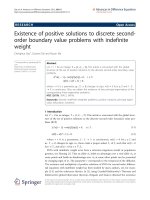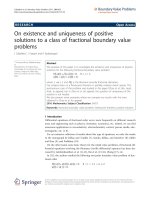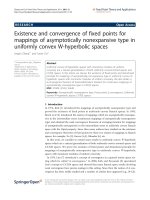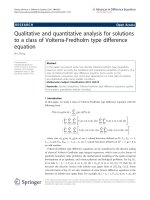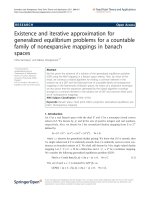Báo cáo hóa học: "EXISTENCE AND NONEXISTENCE OF POSITIVE SOLUTIONS TO A RIGHT-FOCAL BOUNDARY VALUE PROBLEM ON TIME SCALES" pptx
Bạn đang xem bản rút gọn của tài liệu. Xem và tải ngay bản đầy đủ của tài liệu tại đây (543.18 KB, 13 trang )
EXISTENCE AND NONEXISTENCE OF POSITIVE
SOLUTIONS TO A RIGHT-FOCAL BOUNDARY
VALUE PROBLEM ON TIME SCALES
ILKAY YASLAN KARACA
Received 10 October 2005; Revised 19 January 2006; Accepted 30 January 2006
We are concerned with proving the existence of one or more than one positive solution
of an n-point right-focal boundary value problem for the nonlinear dynamic equation
(
−1)
n−1
x
Δ
n
(t) = λr(t) f (t,x
σ
(t)). We will also obtain criteria which lead to nonexistence
of positive solutions. Here the independent variable t is in a time scale. We will use fixed
point theorems for operators on a Banach space.
Copyright © 2006 Ilkay Yaslan Karaca. This is an open access article distributed under
the Creative Commons Attribution License, which permits unrestricted use, distribution,
and reproduction in any medium, provided the original work is properly cited.
1. Introduction
Motivated by the work of Anderson [3] on discrete third-order three-point right-focal
boundary value problems, in this paper we will study an nth-order n-point right-focal
boundary problem on time scales. This paper also gives nonexistence and multiplicity
results for positive solutions to the time scale boundary value problem
(
−1)
n−1
x
Δ
n
(t) = λr(t) f
t,x
σ
(t)
∀
t ∈
t
1
,ρ
t
n
, (1.1)
x
t
1
=
x
Δ
t
2
=···=
x
Δ
n−1
(t
n
) = 0, (1.2)
where n
≥ 2, t
1
<t
2
< ···<t
n−1
<t
n
, λ is a real parameter, and x = x(t) is a desired solu-
tion. The arguments are similar to those used in [9, 13].
In the third section we obtain multiplicity results for this problem with λ
= 1. In the
fourth section existence, nonexistence, and multiplicity results are given for the eigen-
value problem.
To understand this so-called dynamic equation (1.1)onatimescaleT, we need some
preliminary definitions.
Definit ion 1.1. Let T be a nonempt y closed subset of
R and define the forward jump
operator σ(t)att for t<supT by
σ(t):
= inf
s>t: s ∈ T
(1.3)
Hindawi Publishing Corporation
Advances in Difference Equations
Volume 2006, Article ID 43039, Pages 1–13
DOI 10.1155/ADE/2006/43039
2 A right-focal boundary v alue problem on time scales
and the backward jump operator ρ(t)att for t>inf T by
ρ(t):
= sup
s<t: s ∈ T
(1.4)
for all t
∈ T.
We assume throughout that T has the topology that it inherits from the standard topol-
ogy on the real numbers
R.Ifσ(t) >t,wesayt is right scattered, while if ρ(t) <t,wesay
t is left scattered. If σ(t)
= t,wesayt is right dense, while if ρ(t) = t,wesayt is left dense.
We assume σ
0
(t) = t,andforanyintegern>0, we have
σ
n
(t):= σ
σ
n−1
(t)
. (1.5)
Throughout this paper we make the blanket assumption that a
≤ b are points in T.
Definit ion 1.2. Define the interval in T:
[a,b]:
={t ∈ T such that a ≤ t ≤ b}. (1.6)
Other types of intervals are defined similarly.
We are concerned with calculus on time scales which is a unified approach to contin-
uous and discrete calculus. In [4, 11], Aulbach and Hilger have initiated the development
of this calculus. Since then, efforts have been made in the context of time scales, in estab-
lishing that some results for boundary value problems for ordinary differential equations
and their discrete analogues are special cases of more general results on time scales; for a
wide variety of problems addressed, see many references [1, 5, 6, 8–10, 14].
Definit ion 1.3. Assume x : T
→ R and fix t ∈ T such that t<supT,thenx
Δ
(t)isdefined
to be the number (provided it exists) with the property that, given any
> 0, there is a
neighborhood U of t such that
x
σ(t)
−
x(s)
−
x
Δ
(t)
σ(t) − s
<
σ(t) − s
(1.7)
for all s
∈ U. x
Δ
(t)iscalledthedeltaderivativeofx at t.
It can be shown that if x : T
→ R is continuous at t ∈ T, t<supT,andt is right scat-
tered, then
x
Δ
(t) =
x
σ
(t) − x(t)
σ(t) − t
. (1.8)
Note, if T
=
Z
,whereZ is the set of integers, then
x
Δ
(t) = Δx(t):= x(t +1)− x(t). (1.9)
Moreover , if T
= R,then
x
Δ
(t) = x
(t). (1.10)
Ilkay Yaslan Karaca 3
Finally, for n
≥ 1, define
x
Δ
n
(t):=
x
Δ
(t)
Δ
n−1
(1.11)
assuming x
Δ
0
(t) = x(t).
Definit ion 1.4. If F
Δ
(t) = f (t), then define the integral of f by
t
a
f (τ)Δτ := F(t) − F(a). (1.12)
Note that in the case T
=
R
we have
b
a
f (t)Δt =
b
a
f (t)dt, (1.13)
and in the case T
=
Z
we have
b
a
f (t)Δt =
b−1
k=a
f (k), (1.14)
where a,b
∈ T with a ≤ b.
2. Preliminaries
As in [2], we introduce the Taylor polynomials h
j
: T
2
→ R, j ∈ N
0
, recursively defined as
follows:
h
0
(t,s) = 1 ∀ s, t ∈ T, (2.1)
h
j+1
(t,s) =
t
s
h
j
(τ,s)Δτ ∀s,t ∈ T. (2.2)
For integers n
≥ 2andfori = 1,2, ,n − 1, define
u
n,i
(t,s) ≡ u
n,i
t,s : t
1
,t
2
, ,t
n
, (2.3)
with t,s,t
j
∈ T for 1 ≤ j ≤ n,asfollows:
u
n,i
(t,s):= (−1)
n+1
0 h
1
t,t
1
h
2
t,t
1
h
n−1
t,t
1
c
2
(s,i)1h
1
t
2
,t
1
h
n−2
t
2
,t
1
c
3
(s,i)0 1 h
n−3
t
3
,t
1
.
.
.
.
.
.
.
.
.
.
.
.
c
n−1
(s,i)0 0 h
1
t
n−1
,t
1
100 1
, (2.4)
where
c
j
(s,i):= H( j − 1 − i)h
n− j
t
j
,σ(s)
, (2.5)
4 A right-focal boundary v alue problem on time scales
for j
= 2,3, ,n − 1andi = 1,2, ,n − 1. Here
H(x)
=
⎧
⎨
⎩
0ifx<0,
1ifx
≥ 0,
(2.6)
is the usual Heaviside function, and h
j
(t,s)isasdefinedin(2.2). In addition, define
v
n,i
(t,s):= u
n,i
(t,s)+(−1)
n−1
h
n−1
t,σ(s)
, (2.7)
for integers n
≥ 2andfori = 1,2, ,n − 1.
Theorem 2.1 [2]. For u
n,i
(t,s) as in (2.4)andv
n,i
(t,s) as in (2.7),
G
n
t,s : t
1
,t
2
, ,t
n
=
⎧
⎪
⎪
⎪
⎪
⎪
⎪
⎪
⎪
⎪
⎪
⎪
⎪
⎪
⎪
⎪
⎪
⎪
⎨
⎪
⎪
⎪
⎪
⎪
⎪
⎪
⎪
⎪
⎪
⎪
⎪
⎪
⎪
⎪
⎪
⎪
⎩
s ∈ I
1
:
⎧
⎨
⎩
u
n,1
(t,s) if t ≤ σ(s),
v
n,1
(t,s) if t ≥ σ(s),
s
∈ I
2
:
⎧
⎨
⎩
u
n,2
(t,s) if t ≤ σ(s),
v
n,2
(t,s) if t ≥ σ(s),
.
.
.
s
∈ I
n−1
:
⎧
⎨
⎩
u
n,n−1
(t,s) if t ≤ σ(s),
v
n,n−1
(t,s) if t ≥ σ(s),
(2.8)
where I
1
= [t
1
,ρ(t
2
)],andI
i
= [ρ(t
i
),ρ(t
i+1
)] for i = 1, 2, , n − 1, is Green’s function for the
homogeneous problem (
−1)
n−1
x
Δ
n−1
(t) = 0 satis fying the boundary conditions (1.2).
Lemma 2.2 [2]. For s
∈ [t
1
,ρ(t
2
)] and n ≥ 2,
G
n
t,s : t
1
,t
2
, ,t
n
⎧
⎨
⎩
< 0 if t ∈
−∞,t
1
,
> 0 if t
∈
t
1
,σ
n−1
t
n
.
(2.9)
Theorem 2.3 [2]. Let u
n,i
(t,s) and v
n,i
(t,s) begivenasin(2.4)and(2.7), respectively.
Assume for n
≥ 4 that
v
n−i, j−i+1
σ
n−i
t
n
,σ
s
j
: t
i
,t
i+1
, ,t
n−1
> 0, (2.10)
for j
∈{2,3, ,n − 2} and i = j − 1, j − 2, ,1,andfors
j
∈ [ρ(t
j
),ρ(t
j+1
)]. Then
G
n
t,s : t
1
,t
2
, ,t
n
⎧
⎨
⎩
< 0 if t ∈
−∞,t
1
,
> 0 if t
∈
t
1
,σ
n−1
t
n
,
(2.11)
Ilkay Yaslan Karaca 5
for s
∈ [t
1
,ρ(t
n
)] if n is even, or for s ∈ [t
1
,ρ(t
n−1
)] if n is odd. For odd n ≥ 3, the additional
assumption
u
n,n−1
σ
n−1
t
n
+(−1)
n−1
h
n−1
σ
n−1
t
n
,t
n
> 0 (2.12)
yields (2.11)fors
∈ [ρ(t
n−1
),ρ(t
n
)] as well.
Throughout this paper, we assume that the time scale T is such that σ(s)isdeltadif-
ferentiable for all s
∈ T, t
1
is right-scattered, and hypotheses of Theorem 2.3 hold.
Furthermore, we have the following assumptions.
(H1) r(s) is a nonnegative continuous function defined on [t
1
,ρ(t
n
)] satisfying
0 <
t
n
t
1
G
n
(t,s)r(s)Δs<∞, (2.13)
for t
∈ [σ(t
1
),σ
n−1
(t
n
)].
(H2) f :[t
1
,ρ(t
n
)] × R → R is such that f (t,x) ≥ 0forx ∈ R
+
and continuous with
respect to x,where
R
+
denotes the set of nonnegative real numbers.
Let us set
M
n
:= maxG
n
(t,s)r(s), m
n
:= minG
n
(t,s)r(s) (2.14)
for s
∈ [t
1
,ρ(t
n
)], t ∈ [σ(t
1
),σ
n−1
(t
n
)], and
A
1
n
:= max
t∈[σ(t
1
),σ
n−1
(t
n
)]
t
n
t
1
G
n
(t,s)r(s)Δs, A
2
n
:= min
t∈[σ(t
1
),σ
n−1
(t
n
)]
t
n
t
1
G
n
(t,s)r(s)Δs.
(2.15)
We refer to [7, 12] for a discussion of the fixed point index that we use below. In
particular, we will make frequent use of the following lemma.
Lemma 2.4. Let Ꮾ be a Banach space, and let ᏼ
⊂ Ꮾ be a cone in Ꮾ.Assumer>0 and that
Ψ : ᏼ
r
→ ᏼ is compact operator such that Ψx = x for x ∈ ∂ᏼ
r
:={x ∈ ᏼ : x=r}. Then
the following assertions hold.
(i) If
x≤Ψx for all x ∈ ∂ᏼ
r
, then i(Ψ,ᏼ
r
,ᏼ)= 0.
(ii) If
x≥Ψx for all x ∈ ∂ᏼ
r
, then i(Ψ,ᏼ
r
,P) = 1.
Thus, if there exists r
1
>r
2
> 0 such that condition (i) holds for x ∈ ∂ᏼ
r
1
and (ii) holds
for x
∈ ∂ᏼ
r
2
(or (ii) and (i)), then, from the additivity properties of the index, we know
that
i
Ψ,ᏼ
r
1
,ᏼ
=
i
Ψ,ᏼ
r
1
\ int
ᏼ
r
2
,ᏼ
+ i
Ψ,ᏼ
r
2
,ᏼ
. (2.16)
As a consequence of i(Ψ,ᏼ
r
1
\ int(ᏼ
r
2
),ᏼ) = 0, Ψ has a fixed point (nonzero) whose norm
is between r
1
and r
2
.
Consider the Banach space of continuous functions on [t
1
,σ
n−1
(t
n
)] with the norm
x=max
x(t)
, t ∈
σ
t
1
,σ
n−1
t
n
, (2.17)
6 A right-focal boundary v alue problem on time scales
and cone ᏼ in Ꮾ given by
ᏼ
=
x ∈ Ꮾ : x(t) ≥ 0, t ∈
σ
t
1
,σ
n−1
t
n
,min
t∈[σ(t
1
),σ
n−1
(t
n
)]
x(t) ≥
m
n
M
n
x
. (2.18)
By Theorem 2.1, solving the BVP (1.1)–(1.2) is equivalent to solving the following
integral equation in ᏼ:
x(t)
= λ
t
n
t
1
G
n
(t,s)r(s) f
s,x
σ
(s)
Δs, t ∈
t
1
,σ
n−1
t
n
, (2.19)
and consequently, it is equivalent to finding fixed points of the operator Ψ
n
λ
: Ꮾ → Ꮾ
defined by
Ψ
n
λ
x(t):= λ
t
n
t
1
G
n
(t,s)r(s) f
s,x
σ
(s)
Δs, t ∈
t
1
,σ
n−1
t
n
. (2.20)
First, we prove that for every λ>0 given, this operator maps the cone ᏼ in itself.
Lemma 2.5. Let λ>0 be given. Unde r the hypotheses (H1) and (H2), the operator Ψ
n
λ
is a
compact operator such that Ψ
n
λ
(ᏼ) ⊂ ᏼ.
Proof. That Ψ
n
λ
is a compact operator follows by Arzela-Ascoli’s theorem. Next, for all
x
∈ ᏼ, by (H1), (H2), and the positivit y property of the Green function, we have from
(2.20), Ψ
n
λ
x(t) ≥ 0forallt ∈ [ σ(t
1
),σ
n−1
(t
n
)]. If x ∈ ᏼ,then
min
t∈[σ(t
1
),σ
n−1
(t
n
)]
Ψ
n
λ
x(t) ≥ λm
n
t
n
t
1
f
s,x
σ
(s)
Δs
≥ λ
m
n
M
n
t
n
t
1
max
t∈[σ(t
1
),σ
n−1
(t
n
)]
G
n
(t,s)r(s)
f
s,x
σ
(s)
Δs
≥ λ
m
n
M
n
max
t∈[σ(t
1
),σ
n−1
(t
n
)]
t
n
t
1
G
n
(t,s)r(s) f
s,x
σ
(s)
Δs
=
m
n
M
n
Ψ
n
λ
x
.
(2.21)
Therefore, Ψ
n
λ
x ∈ ᏼ.
3. Noneigenvalue problem
In this section we study the existence of at least two positive solutions to the following
BVP:
(
−1)
n−1
x
Δ
n
(t) = r(t) f
t,x
σ
(t)
∀
t ∈
t
1
,ρ
t
n
,
x
t
1
=
x
Δ
t
2
=···=
x
Δ
n−1
t
n
=
0,
(3.1)
whichisproblem(1.1)-(1.2)withλ
= 1. As an application, we also give an example to
demonstrate our result.
Theorem 3.1. The boundary value problem (3.1) has at least two positive solutions, x
1
and
x
2
, if (H1) and (H2) are satisfied and, in addition, both of the following hold.
Ilkay Yaslan Karaca 7
(H3) There exists 0 <k<R<+
∞ such that
f (t,x) >
M
n
m
2
n
t
n
− t
1
x ∀x ∈ [0,k]
[R,+∞],t ∈
t
1
,ρ
t
n
. (3.2)
(H4) There exists p>0 such that
f (t,x) <
p
M
n
t
n
− t
1
∀
x ∈ [0, p], t ∈
t
1
,ρ
t
n
, (3.3)
where M
n
and m
n
are given as (2.14). Moreover, 0 < x
1
<p<x
2
.
Proof. Let x
∈ ∂ᏼ
k
. From condition (H3), we have
A
1
n
=
max
t∈[σ(t
1
),σ
n−1
(t
n
)]
t
n
t
1
G
n
(t,s)r(s) f
s,x
σ
(s)
Δs
>m
n
M
n
m
2
n
t
n
− t
1
t
n
t
1
x
σ
(s)Δs
≥
M
n
m
n
t
n
− t
1
m
n
M
n
x
t
n
t
1
Δs =x.
(3.4)
If x
∈ ∂ᏼ
R
1
, R
1
≥ M
n
/m
n
R,wehave
min
t∈[σ(t
1
),σ
n−1
(t
n
)]
x(t) ≥
m
n
M
n
x=
m
n
M
n
R
1
≥ R. (3.5)
Hence x(s)
≥ R for all s ∈ [t
1
,ρ(t
n
)]. Therefore using condition (H3) again, we arrive at
thesameconclusion.
Now, from (H4), if
x=p,
A
1
n
=
max
t∈[σ(t
1
),σ
n−1
(t
n
)]
t
n
t
1
G
n
(t,s)r(s) f
s,x
σ
(s)
Δs
≤
t
n
t
1
M
n
f
s,x
σ
(s)
Δs<x.
(3.6)
Since we can choose k>0 small enough and R
1
sufficiently large so that k<p<R
1
,we
assure the existence of two solutions: x
1
∈ ᏼ
p
\ int(ᏼ
k
)andx
2
∈ ᏼ
R
1
\ int(ᏼ
p
).
Example 3.2. We illustrate Theorem 3.1 with specific time scale
T
= T
c
=
c
m
: m ∈ Z
∪{0}, (3.7)
where c>1 and the following specific parameter values for n
= 3. Let c = 11/10, t
1
= 1,
t
2
= (11/10)
3
,andt
3
= (11/10)
4
. Bohner and Peterson [6] show that
h
j
(t,s) =
j−1
ν=0
t − c
ν
s
ν
μ
=0
c
μ
(3.8)
8 A right-focal boundary v alue problem on time scales
for all s,t
∈ T. Using this formula, we have
G
3
(t,s)
=
⎧
⎪
⎪
⎪
⎪
⎪
⎪
⎪
⎪
⎪
⎪
⎪
⎪
⎪
⎪
⎪
⎨
⎪
⎪
⎪
⎪
⎪
⎪
⎪
⎪
⎪
⎪
⎪
⎪
⎪
⎪
⎪
⎩
s ∈
1,
11
10
2
:
⎧
⎪
⎪
⎪
⎪
⎪
⎨
⎪
⎪
⎪
⎪
⎪
⎩
(t − 1)
11
10
s
− 1
if t ≤
11
10
s,
(t
− 1)
11
10
s
− 1
+
10
21
t −
11
10
s
t −
121
100
s
if t ≥
11
10
s,
s
∈
11
10
2
,
11
10
3
:
⎧
⎪
⎪
⎪
⎨
⎪
⎪
⎪
⎩
331
1000
(t
− 1) if t ≤
11
10
s,
331
1000
(t
− 1) +
10
21
t −
11
10
s
t −
121
100
s
if t ≥
11
10
s.
(3.9)
If r(s)
= s,thenm
3
=minG(t,s)r(s)=10
−2
, M
3
=maxG(t,s)r(s)=3870659646821 · 10
−13
for t ∈ [11/10,(11/10)
6
],s ∈ [1,(11/10)
3
].
Let k
= 1/18000, p = 1/5, R = 2/5, let
f (t,x)
=
⎧
⎪
⎪
⎪
⎪
⎪
⎪
⎪
⎪
⎪
⎪
⎪
⎪
⎪
⎪
⎨
⎪
⎪
⎪
⎪
⎪
⎪
⎪
⎪
⎪
⎪
⎪
⎪
⎪
⎪
⎩
2.10
4
k sin
tπ
6
if x
∈ [0,k],
L(x)sin
tπ
6
if x
∈ [k, p],
K(x)sin
tπ
6
if x
∈ [p,R],
2.10
4
k +1
R
x sin
tπ
6
if x
∈ [R,+∞),
(3.10)
where
L(x)
= 1+
p
− x
p − k
2.10
4
k − 1
,
K(x)
= 1+
p
− x
p − R
2.10
4
(k +1)− 1
.
(3.11)
Note that f is continuous and nonnegative valued for x
≥ 0.
For t
∈ [1,(11/10)
3
]andx ∈ [0,k]
[R,∞), f (t, x) > (8340,14144, )x. Indeed; for
x
∈ [0,k], f (t,x) = 2.10
4
k sin(tπ/6) ≥10
4
k>(8340,14144, )x,forx ∈ [R,∞), f (t,x) =
2.10
4
((k +1)/R)xsin(tπ/6) ≥ 10
4
((k +1)/R)x = (900050/36)x>(8340,14144, )x.So
(H3) is verified.
For x
∈ [0,k], f (t,x) = 2.10
4
k sin(tπ/6) < 2.10
4
k<p/0,17963731420896261.
For x
∈ [k, p], f (t,x)=1+((p − x)/(p − k))[2.10
4
k − 1]sin(tπ/6) ≤ 2.10
4
k sin(tπ/6) <
2.10
4
k<p/0,17963731420896261. Hence it verifies the (H4).
We conclude from Theorem 3.1 that for these parameter values, (3.1)forn
= 3 has at
least two positive solutions, x
1
and x
2
such that 0 < x
1
< 1/5 < x
2
.
Ilkay Yaslan Karaca 9
4. Eigenvalue problem
Define the nonnegative extended real numbers f
0
, f
0
, f
∞
,and f
∞
by
f
0
:= liminf
x→0
+
min
t∈[t
1
,ρ(t
n
)]
f (t,x)
x
, f
0
:= limsup
x→0
+
max
t∈[t
1
,ρ(t
n
)]
f (t,x)
x
,
f
∞
:= liminf
x→∞
min
t∈[t
1
,ρ(t
n
)]
f (t,x)
x
, f
∞
:= limsup
x→∞
max
t∈[t
1
,ρ(t
n
)]
f (t,x)
x
,
(4.1)
respectively .
These numbers can be regarded as generalized super or sublinear conditions on the
function f (t,x)atx
= 0andx =∞. Thus, if f
0
= f
0
= 0(+∞), then f (t, x) is superlinear
(sublinear) at x
= 0andif f
∞
= f
∞
= 0(+∞), then f (t, x) is sublinear (superlinear) at
x
= +∞.
First, we obtain an existence result for λ belonging to a given interval.
Theorem 4.1. If (H1)-(H2) hold and either
(a) M
n
/(m
n
A
2
n
f
0
) <λ<1/(A
1
n
f
∞
),or
(b) M
n
/(m
n
A
2
n
f
∞
) <λ<1/(A
1
n
f
0
)
is satisfied, where M
n
, m
n
, A
1
n
,andA
2
n
are given as in (2.14)and(2.15), then the eigenvalue
problem (1.1)-(1.2) has at least one positive solution.
Proof. Assume (a) holds. First we consider f
0
< ∞.Since
M
n
m
n
A
2
n
f
0
<λ, (4.2)
there is an
> 0sothat
λ
f
0
−
m
n
M
n
A
2
n
≥ 1. (4.3)
Using the definition of f
0
, there is an r
1
> 0, sufficiently small, so that
f
0
−
< min
t∈[t
1
,ρ(t
n
)]
f (t,x)
x
(4.4)
for 0 <x
≤ r
1
.
It follows that f (t,x) > ( f
0
−
)x for 0 <x≤ r
1
, t ∈ [t
1
,ρ(t
n
)].
Assume that x
∈ ∂ᏼ
r
1
,then
Ψ
n
λ
x(t) = λ
t
n
t
1
G
n
(t,s)r(s) f
s,x
σ
(s)
Δs
>λ
f
0
−
t
n
t
1
G
n
(t,s)r(s)x
σ
(s)Δs
≥ λ
f
0
−
m
n
M
n
xA
2
n
≥x.
(4.5)
10 A right-focal boundary value problem on time scales
Next, we consider the case f
0
=∞.ChooseK>0sufficiently large so that
λK
m
n
M
n
A
2
n
≥ 1 (4.6)
for any t
∈ [t
1
,σ
n−1
(t
n
)].
So there exists r
1
> 0sothat f (t,x) >Kxfor 0 <x≤ r
1
.
Assume that x
∈ ∂ᏼ
r
1
,then
Ψ
n
λ
x(t) >λK
t
n
t
1
G
n
(t,s)r(s)x
σ
(s)Δs ≥ λK
m
n
M
n
xA
2
n
≥x. (4.7)
Finally, we use the assumption
λ<
1
A
1
n
f
∞
. (4.8)
Pick an
1
> 0sothat
λ
f
∞
+
1
A
1
n
≤ 1. (4.9)
Using the definition of f
∞
, there is an r>r
1
sufficiently large, so that
max
t∈[t
1
,ρ(t
n
)]
f (t,x)
x
<f
∞
+
1
, (4.10)
for x
≥ r.
It follows that f (t,x) < ( f
∞
+
1
)x for x ≥ r.
We now show that there is an r
2
≥ r such that if x ∈ ∂ᏼ
r
2
,thenΨ
n
λ
x < x.
Pick r
2
≥ rM
n
/m
n
>r
1
.Nowassumex ∈ ∂ᏼ
r
2
and consider
Ψ
n
λ
x(t) <λ
f
∞
+
1
t
n
t
1
G
n
(t,s)r(s)x
σ
(s)Δs ≤ λ( f
∞
+
1
)A
1
n
x≤x. (4.11)
Therefore, by Lemma 2.4, Ψ
n
λ
has a fixed point x with r
1
< x <r
2
. This shows that
condition (a) yields the existence of a positive solution of the eigenvalue problem (1.1)-
(1.2). This completes the proof of the theorem.
The proof of part (b) is similar.
Our next results give criteria for the existence of one, more than one, or no positive
solutions of the eigenvalue problem (1.1)-(1.2) in terms of the superlinear or sublinear
behavior of f (t,x). For the next three theorems, in addition to the assumptions (H1) and
(H2) we assume.
(H5) f (t,x) > 0on[t
1
,ρ(t
n
)] × R
+
.
Theorem 4.2. If hypotheses (H1), (H2), and (H5) are satisfied, then the following asser tions
hold.
(a) If f
0
=∞or f
∞
=∞, then there is a λ
0
> 0 such that for all 0 <λ≤ λ
0
the eigenvalue
problem (1.1)-(1.2) has a positive solution.
Ilkay Yaslan Karaca 11
(b) If f
0
= 0 or f
∞
= 0, then there is a λ
0
> 0 such that for all λ ≥ λ
0
the eigenvalue
problem (1.1)-(1.2) has a positive solution.
Proof of p art (a). Let r>0begiven.Fromconditions(H2)and(H5)wecandefine
L :
= max
f (t,x):(t,x) ∈
t
1
,ρ
t
n
×
[0,r]
> 0. (4.12)
Then if x
∈ ∂ᏼ
r
, it follows that
Ψ
n
λ
x(t) ≤ λL
t
n
t
1
G
n
(t,s)r(s)Δs ≤ λLA
1
n
. (4.13)
It follows that we can pick λ
0
> 0sufficiently small so that for all 0 <λ≤ λ
0
,
Ψ
n
λ
x
≤
x (4.14)
for all x
∈ ∂ᏼ
r
.
Fix λ
≤ λ
0
.ChooseT>0sufficiently large so that
λ
m
n
M
n
TA
2
n
≥ 1. (4.15)
Since f
0
=∞, there exists s<rsuch that
min
t∈[t
1
,ρ(t
n
)]
f (t,x)
x
>T (4.16)
for 0 <x
≤ s.Hence,wehavethat
f (t,x) >Tx for t
∈
t
1
,ρ
t
n
,0<x≤ s. (4.17)
Now, let x
∈ ∂ᏼ
s
. In this case,
Ψ
n
λ
x(t) >λT
t
n
t
1
G
n
(t,s)r(s)x
σ
(s)Δs ≥ λT
m
n
M
n
xA
2
n
≥x (4.18)
for t
∈ [σ(t
1
),σ
n−1
(t
n
)]. Hence we have shown that if x ∈ ∂ᏼ
s
,thenΨ
n
λ
x≥x.
It follows from Lemma 2.4 that the operator Ψ
n
λ
has a fixed point.
When f
∞
=∞, there is a w>rsuch that
min
t∈[t
1
,ρ(t
n
)]
f (t,x)
x
>T (4.19)
for x
≥ ω.
It follows that f (t,x) >Txfor t
∈ [t
1
,ρ(t
n
)], x ≥ ω.
Let ω
0
:= ωM
n
/m
n
.Nextifx ∈ ∂ᏼ
ω
0
, then we show that Ψ
n
λ
x > x.Infact,
Ψ
n
λ
x(t) >λT
t
n
t
1
G
n
(t,s)r(s)x
σ
(s)Δs ≥ λT
m
n
M
n
xA
2
n
≥x (4.20)
for t
∈ [t
1
,σ
n−1
(t
n
)]. This completes the proof of part (a).
12 A right-focal boundary value problem on time scales
Part (b) holds in an analogous way.
Similar to the proof of Theorem 4.2, we get the next result.
Theorem 4.3. Under the hypotheses of Theorem 4.2, the following assertions hold.
(a) If f
0
= f
∞
=∞, then there is a λ
0
> 0 such that for all 0 <λ≤ λ
0
,theeigenvalue
problem (1.1)-(1.2) has two positive solutions.
(b) If f
0
= f
∞
= 0, then there is a λ
0
> 0 such that for all λ ≥ λ
0
, the eigenvalue problem
(1.1)-(1.2)hastwopositivesolutions.
Now, we give a nonexistence result as follows.
Theorem 4.4. Under the hypotheses of Theorem 4.2, the following assertions hold.
(a) If there is a constant c>0 such that f (t, x)
≥ cx for x ≥ 0, then there is a λ
0
> 0 such
that the eigenvalue problem (1.1)-(1.2) has no positive solutions for λ
≥ λ
0
.
(b) If there is a constant c>0 such that f (t, x)
≤ cx for x ≥ 0, then there is a λ
0
> 0 such
that the eigenvalue problem (1.1)-(1.2) has no positive solutions for 0 <λ
≤ λ
0
.
Proof of p art (b). Assume there is constant c>0suchthat f (t,x)
≤ cx for x ≥ 0. Assume
x(t) is a positive solution of the eigenvalue problem (1.1 )-(1.2). We will show that for λ
sufficiently small and positive that this leads to a contradiction. Since Ψ
n
λ
x(t) = x(t)for
t
∈ [t
1
,σ
n−1
(t
n
)],
x(t)
= λ
t
n
t
1
G
n
(t,s)r(s) f
s,x
σ
(s)
Δs ≤ cλ
t
n
t
1
G
n
(t,s)r(s)x
σ
(s)Δs
≤ cλx
t
n
t
1
G
n
(t,s)r(s)Δs ≤ cλA
1
n
x
(4.21)
for t
∈ [t
1
,σ
n−1
(t
n
)]. Pick λ
0
sufficiently small so that for 0 <λ≤ λ
0
,
cλA
1
n
< 1, (4.22)
then we have x(t) <
x for t ∈ [t
1
,σ
n−1
(t
n
)] which is a contradiction.
The proof of part (a) is similar.
References
[1] R. P. Agarwal and M. Bohner, Basic calculus on time scales and some of its applications, Results in
Mathematics 35 (1999), no. 1-2, 3–22.
[2] D. R. Anderson, Positivity of Green’s function for an n-point right focal boundary value problem on
measure chains, Mathematical and Computer Modelling 31 (2000), no. 6-7, 29–50.
[3]
, Discrete third-order three-point right-focal boundary value problems, Computers &
Mathematics with Applications 45 (2003), no. 6–9, 861–871.
[4] B. Aulbach, Analysis auf Zeitmengen, Lecture Notes, Universitat Augsburg, Augsburg, 1990.
[5] K. L. Boey and P. J. Y. Wong, Two-point right focal eigenvalue problems on time scales,Applied
Mathematics and Computation 167 (2005), no. 2, 1281–1303.
[6] M. Bohner and A. Peterson, Dynamic Equations on Time Scales. An Introduction with Applica-
tions,Birkh
¨
auser Boston, Massachusetts, 2001.
[7] K. Deimling, Nonlinear Functional Analysis, Springer, Berlin, 1985.
[8] L. Erbe and A. Peterson, Eigenvalue conditions and positive solutions,JournalofDifference Equa-
tions and Applications 6 (2000), no. 2, 165–191.
Ilkay Yaslan Karaca 13
[9] , Positive solutions for a nonlinear differential equation on a measure chain, Mathematical
and Computer Modelling 32 (2000), no. 5-6, 571–585.
[10] L. Erbe, A. Peterson, and R. Mathsen, Existence, multiplicity, and nonexistence of positive solutions
to a differential equation on a measure chain, Journal of Computational and Applied Mathematics
113 (2000), no. 1-2, 365–380.
[11] S. Hilger, Analysis on measure chains—a unified approach to continuous and discrete calculus,
Results in Mathematics 18 (1990), no. 1-2, 18–56.
[12] M. A. Krasnosel’ski
˘
ı, Positive Solutions of Operator Equations, Groningen and P. Noordhoff,The
Netherlands, 1964.
[13] F. Merdivenci Atici, A. Cabada, and V. Otero-Espinar, Criteria for existence and nonexistence of
positive solutions to a discrete periodic boundary value problem,JournalofDifference Equations
and Applications 9 (2003), no. 9, 765–775.
[14] F. Merdivenci Atici and G. Sh. Guseinov, On the existence of positive solutions for nonlinear dif-
ferential equations with periodic boundary conditions, Journal of Computational and Applied
Mathematics 132 (2001), no. 2, 341–356.
Ilkay Yaslan Karaca: Department of Mathematics, Ege University, 35100 Bornova, Izmir, Turkey
E-mail address:


